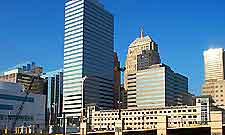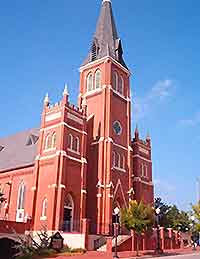Oklahoma City History Facts and Timeline
(Oklahoma City, Oklahoma - OK, USA)

Compared with the cities along America's eastern coast, Oklahoma City got a rather late start in life, but it certainly has an unusual history. From the day settlers arrived during the 1889 Land Run, Oklahoma City seemed destined to become a place of opportunism and statement.
From oil booms to domestic terrorism, this city has had a poor run of luck in recent decades and is currently trying to re-establish itself as a desirable place to live and work.
The Land Run
In an event that would seem to epitomize the American perspective on things, Oklahoma City was created in 1889 during the infamous Land Run. As part of the federal government's plan to spread its control deeper into the American Midwest, it created a series of homesteading lotteries by which pioneering Americans could buy their own piece of raw land.
The site of Oklahoma City was in an area known as the Unassigned Lands, meaning that it was technically part of the traditional Native American territories, but the government had not yet decided to 'assign' it to any particular Indian tribe. On 22nd April 1889, around 10,000 homesteaders lined up to race across the prairie in the hope of staking a claim on a fertile piece of land.
A New Commercial Hub
Oklahoma City quickly emerged as the capital of this frontier territory and when Oklahoma was granted statehood to the union in 1907, the city was voted in as the official capital of the new state. The railroad ran right through the city, shaping it into an important regional hub of commerce and transport. Meatpacking plants and other locally useful industries popped up, and soon the city center had a trolley system and a fast-growing infrastructure.

Oil Discovery
When oil was discovered within the city limits in 1928, the history of Oklahoma City took a radical change of course. Oil wells sprouted up all over the place, even on the lawn of the State Capital Building. The sudden influx of cash into the city spurred a burst of development and prosperity. By a stroke of luck, oil saved Oklahoma City from the worst of the Great Depression, while the rest of the state suffered terribly.
From Boom to Bust
Once the oil inevitably dried up, Oklahoma City began a slow, steady decline that lasted decades. From the 1960s onwards, many residents left the city. The Central Business District fell into disuse as property values plummeted and shops closed. A disastrous downtown revival plan to inject new life into the city center did little more than level much of its historic architecture before running out of funding.
In recent years, the city officials have tried to correct the course of Oklahoma City's history by luring new companies to the area, creating jobs and boosting the local economy. Plans were derailed in 1995, however, when Timothy McVeigh bombed the Alfred P. Murrah Federal Building with a truck of explosives. The site is now the home of the Oklahoma City National Memorial, marking the spot of America's biggest act of domestic terrorism to date.
 Compared with the cities along America's eastern coast, Oklahoma City got a rather late start in life, but it certainly has an unusual history. From the day settlers arrived during the 1889 Land Run, Oklahoma City seemed destined to become a place of opportunism and statement.
Compared with the cities along America's eastern coast, Oklahoma City got a rather late start in life, but it certainly has an unusual history. From the day settlers arrived during the 1889 Land Run, Oklahoma City seemed destined to become a place of opportunism and statement.